It was our last day in Patagonia, and it might have been the best day, at least as far as the weather went. Furiously blue skies. Not a breath of the wind that had punished us the day before. Clouds? What clouds?
Some days, you just feel it, you know?
As we clamored out of the trucks on the banks of the Rio Chimehuin four our ninth straight day of fishing, we felt it. Caddis swarms hovered over streamside willows, and the river boiled with risers. As we donned waders and waited for the guides to get the boats squared away, we watched as foot-long trout erupted from the river in pursuit of the flitting bugs, sometimes catching them, sometimes not.
A dry-fly day.
Now, there are a lot of dry-fly days in Argentina. In fact, the go-to rig our guides almost always set us up with to start was a size 6 Chernobyl equipped with a dropper—a trusted Perdigon nymph, or something buggy and dependable. It’s a big-fish rig, and that’s what Patagonia is all about, right?
But on this day, with fish clearly keyed in on the caddis, the guy calling the shots for the day, Andres—one of the many stellar guides from Patagonia River Guides—didn’t hesitate to match the hatch. I pulled out my Idaho trout box, and Andres pointed to a size 12 Elk-hair Caddis with an olive-green body.
“That one,” he said. “Use that one.”
I stuck a nice, 14-inch rainbow in the fast water before Andres had even pulled the anchor in. Damn. It was going to be one of those days.
And off we went, bouncing down the Chimehuin on what might have been the perfect day for a float. Caddis were everywhere. Fish were everywhere, too. Tight against the bank. In the soft water behind rocks and willows. In the rapids. Everywhere.
And, oh what fun it was.
But then something troubling began to tickle the back of my brain … a little, “Psst. Hey, buddy. Don’t you remember?”
Remember what?
And then I heard the voice of Tom Rosenbauer, the legendary angler and 40-year Orvis employee. Suddenly, I was transported from perhaps the most picture-perfect day in Patagonia to the cramped quarters of the loft at Trout Hunter on the Henry’s Fork one snowy October night the year before. My friend Todd Tanner had asked me to come up and sit in on the School of Trout sessions he was holding at the lodge, and Tom was giving his lecture to Todd’s students, with the help of a slide presentation. He clicked to a new slide, and there was a photograph of your average adult caddis.
“The caddis is the most dishonest fly ever,” Rosenbauer said. The room went deathly quiet. I remember turning my head and giving Tom the proverbial side-eye.
“What?” I asked under my breath. “A dishonest fly?”
Tom didn’t leave me hanging. And the explanation was brilliant.
Here’s the gist. Adult caddisflies spend precious little time on the water—usually only when they dip and dance during the egg-laying process. Most of the time, adult caddisflies are well above the surface of the water, flying about largely out of reach or resting in the branches of overhanging vegetation. That’s why, during a prolific hatch, you’ll often see smaller trout leaping completely out of the water trying to grab airborne bugs.
“That’s too much work for a big trout,” I remember Tom saying. “You don’t see 20-inch trout expending that much energy chasing caddisflies. It’s just not worth it.”
Instead, Tom said, bigger fish tend to look for easier meals—bites of protein that don’t require the output of much energy. Generally speaking, trout are a lot like other fishy predators. If they can, they’ll wait for meals to come to them. And caddis … well, healthy, adult caddisflies are just too unpredictable. Or, as Tom put it, just too dishonest.
But when caddis actually hatch from the water, often it takes them some time to free themselves of their pupal shuck. Sometimes, the flies get stuck in the surface film as the shuck weighs them down. This “cripple” version of the fly … well, that’s at the top of the big-fish dinner wish list, Rosenbauer explained. The fly is stuck in the surface film. It’s not going to fly off or dance and dip and dive or do anything “dishonest.” It’s there for the taking. An easy meal.
I opened my eyes again in the back of the drift boat on that perfect Patagonian day. I reeled my line in and took a look at my generally average caddis fly. I took out my nippers, and trimmed the hackle along the bottom of the fly. Then I trimmed off about half of the elk hair bunched near the head and thinned out the dubbing near the bend in the hook. I dropped the fly in the river and noticed that it floated quite a bit lower in the water—not like an adult, but like a caddis caught in the surface film. It’s tail end was actually in the water, not on it.
I gave the altered fly a dusting of desiccant and started casting. Andres pointed out a nice slick of soft water just behind an overhanging willow branch—the target was about the size of a basketball hoop. It wasn’t a tough cast—maybe 20 feet. I dropped the rebuilt fly right behind the willow, and almost immediately, the fly disappeared.
“Set!” Andres shouted. I lifted the rod and came tight to much larger trout—a brown trout that pushed 18 inches.
Everything was different about that fish. The fly was obviously different. The take wasn’t the splashy, panicky take of a foot-long trout worried that it’s dinner might escape. Instead, it was a patient sip. The subtle, confident gulp of a trout that knew exactly what it wanted—a delivered meal courtesy of the angling version of Grub Hub.
And all it took was a pair of nippers and the memory of a good lesson learned one wintry Idaho night from a fly-fishing icon. Lessons are lessons for a reason. If you can remember them, you can fool trout. Anywhere.









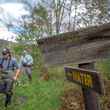




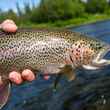
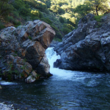




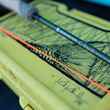








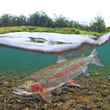
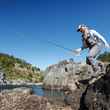
Comments
Bob replied on Permalink
You're describing a Bob Wyatt pattern. My colleagues and I have trimmed all our sedge patterns as you describe. With the same results you describe. Good on you. Never too late to learn.
Pages